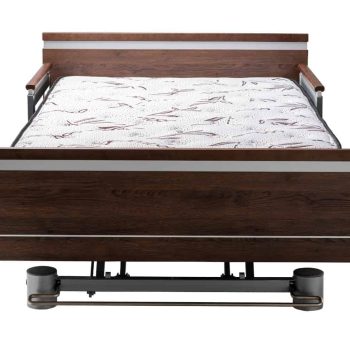

Hospital Beds
Why Do Some People Need An Extra Wide Hospital Bed?
SonderCare Learning Center

SonderCare Learning Center
Why Do Some People Need An Extra Wide Hospital Bed? When purchasing a hospital bed, a patient or their family may find limits to the sizes available to them. The most common size for hospital beds is smaller than a twin-sized or full-sized bed frame – this isn’t enough space for many users! Depending on the model, you’ll find SonderCare beds that are wider and longer than the conventional size. Why would some users need an extra-wide hospital bed?
Conventional hospital beds measure 36 inches wide and 80 inches long, from the frame inside the headboard to the footboard. The weight capacity of a standard bed is up to 450 pounds.
The size of extra-large hospital beds is naturally different than that of standard models. Some specialty types can be as narrow as 24 inches or as wide as 54 inches.
Many patients choose extra-wide hospital beds because they have more resting space on which to get comfortable. They might feel boxed in by a twin size, especially if it was the size they had during a hospital stay. Since they’ll be spending the time in the bed after being discharged, they may want the resting surface to be as great as possible.
It’s especially true if you or your loved one has become used to sleeping in a queen or king-sized bed. Moving from that size to a twin can be difficult for many people to accept, and an extra-wide model can let them get more of the space to which they’ve grown accustomed.
Users taller than an average person or have a higher body mass index (BMI) may benefit more by having one of these beds. Extra-wide beds don’t just have more sleeping space – they can accommodate heavier users, with some able to handle patients weighing as much as 1000 pounds. As such, many hospitals and manufacturers will call hospital beds greater than the standard 36” “bariatric,” regardless of the user’s actual weight or the reason they need an extra-wide model.
It can have important implications for their rest, recovery, and the prevention of further injuries. A bed too small to allow patients to turn from a supine position to lying on their side increases the difficulty of mobilizing patients. Improper sizing can increase the risk of pressure injuries to patients, reduce their comfort, and raise the probability of musculoskeletal injury in caregivers.
As you can see, choosing between a conventionally sized and an extra-wide hospital bed depends on several factors: the patient’s weight and height, the space available in the room where the bed will be, and how comfortable they feel in bed. There also needs to be enough room to adjust the bed and let a caregiver walk around the bed and do their personal care tasks.
One can make the selection using the patient’s BMI. While it doesn’t factor in all considerations and can be misleading, BMI can be a starting point for making the correct choice. If the patient has a higher BMI than 45, they will likely need a hospital bed that’s at least 39″ wide.
Height is another metric. Taller users generally have longer arms and could use the extra space to move and become comfortable. For their legs, the user can add extensions to the end of the bed to give extra length to the bed frame and mattress.
It’s also necessary to consider the patient’s medical and mobility needs. Does the user have an illness, injury, or mobility impairment that an extra-wide hospital bed could better accommodate? Does their condition make them prone to bedsores? These problems can make recoveries longer and more difficult to handle, but a properly-sized hospital bed can accommodate these conditions and prevent complicating situations.
For clients looking for a wider bed, the Aura™ Premium Hospital Bed is now available in an extra-wide 48”. It’s a model that provides all the safety and mobility functions of the original Aura™ Premium while providing extra space on the bed.
If you’re considering installing a hospital-style bed at home for yourself or someone else, be sure to measure out the space first and think about your needs or those of your loved one – it’s essential to get the right fit.
The hospital bed is usually the piece of technology with which the client has the greatest interaction, and it is crucial to the majority of elements of nursing care. A hospital bed’s usual width is 91 cm (36 in. ), but 102 cm (40 in.) and 127 cm (50 in.) widths are also offered.
A bariatric hospital bed or heavy duty hospital bed often has a higher weight capacity as well as wider proportions.
Start Exploring Hospital Beds With SonderCare
Are you recently discharged from hospital, experiencing mobility issues, or in need of palliative or senior care? Enjoy a smoother recovery and get the luxury you deserve by choosing our home hospital products. Contact us today to discuss home hospital beds, mattresses, stand assist chairs and other accessories to make your home hospice perfect for a truly comfortable experience.
Are you looking for the most recent articles on buying hospital beds? Browse our latest resources below and let us know if you have any questions. We’re here to support you as you embark on your road to home medical care.
Seeking The Best Care For Your Loved One?
Browse North America's Luxury
Home Medical Supplies
Inventory